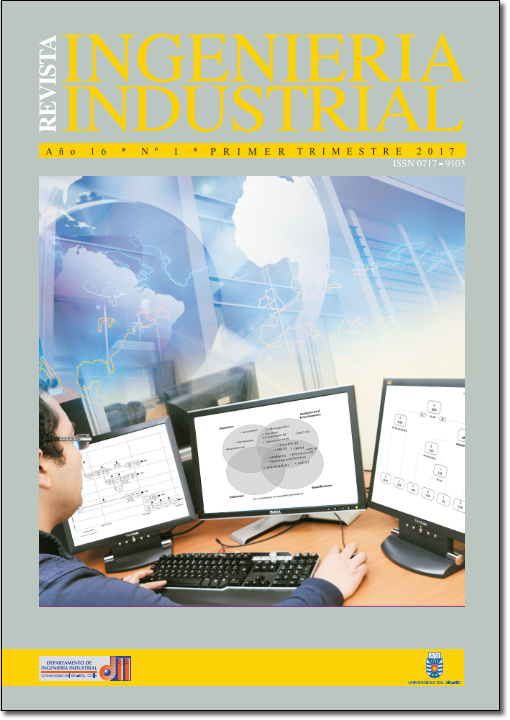CONCEPTUAL MODEL TO PDP SERVITIZATION THROUGH CROSSFUNCTIONAL KNOWLWLEDGE TRANSFER
DOI:
https://doi.org/10.22320/s07179103/2017.04Palabras clave:
Servitização, Desenvolvimento de Produto, Transferência de Conhecimento InterfuncionalResumen
No contexto de adoção da estratégia de servitização, o processo de desenvolvimento do produto (PDP) é altamente dependente da geração de novos conhecimentos para fornecer soluções de integradas de produtos e serviços. Nesse contexto, a área de suporte de produto tem o potencial de agregar ao time de PDP conhecimento sobre oportunidades, desenvolvimento e entrega de serviços. No entanto, falta orientação sobre como as empresas podem conduzir essa integração da área de suporte ao produto com outras áreas do PDP mirando na servitização da oferta. Assim, o objetivo desse artigo é propor um modelo conceitual com enfoque na transferência de conhecimento (TC) interfuncional durante o PDP para servitização. O modelo conceitual foi desenvolvido através de uma revisão da literatura sobre aspectos da TC interfuncional no PDP e da servitização. Na sequência, o modelo conceitual proposto foi confrontado com a prática por meio de seis estudos de casos em empresas servitizadas. Como resultado, o modelo conceitual proposto concentra-se em trazer a TC a partir da área de suporte de produto para os estágios iniciais da definição de problema, a fim de substituir modelos mentais tradicionais de empresas de manufatura apenas focados na oferta de produtos.
Descargas
Citas
ARGYRIS, C and SCHÖN, D.A. Organizational learning. Reading, Mass.: Addison-Wesley Pub. Co., 1978. Addison-Wesley series on organization development. ISBN 0-201-00174-8
ARGYRIS, C. Single-loop and double-loop models in research on decision making. Administrative science quarterly, 1976, 363-375.
AURICH, J.C., FUCHS, C and WAGENKNECHT, C. Life cycle oriented design of technical Product-Service Systems. Journal of Cleaner Production, 2006, 14(17), 1480- 1494.
AYALA, N.F., PASLAUSKI, C. A., RIBEIRO, J. L.D and FRANK, A.G. An analysis of buyer-supplier integration for servitization strategies. Procedia CIRP, 2016, 47, 388-393.
AYALA, N. F., PASLAUSKI, C. A., GHEZZI, A and FRANK, A.G. Knowledge sharing dynamics in service suppliers' involvement for servitization of manufacturing companies. International Journal of Production Economics, 2017, 193, 538-553.
BAINES, T., LIGHTFOOT, H., PEPPARD, J., JOHNSON, M., TIWARI, A., SHEHAB, E and SWINK, M. Towards an operations strategy for product-centric servitization. International Journal of Operations & Production Management, 2009, 29(5), 494-519.
BAINES, T., W and LIGHTFOOT, H. Servitization of the manufacturing firm: Exploring the operations practices and technologies that deliver advanced services. International Journal of Operations & Production Management, 2013, 34(1), 2-35.
BAKER, W. E and SINKULA, J. M. Market orientation, learning orientation and product innovation: delving into the organization's black box. Journal of market-focused management, 2002, 5(1), 5-23.
BARNEY, J. Firm resources and sustained competitive advantage. Journal of management, 1991, 17(1), 99-120.
BAUNSGAARD, V. V and CLEGG, S. ‘Walls or boxes’: The effects of professional identity, power and rationality on strategies for cross-functional integration. Organization Studies, 2013, 34(9), 1299-1325.
BRETTEL, M., HEINEMANN, F., E. A and NEUBAUER, S. Cross-functional integration of R&D, marketing, and manufacturing in radical and incremental product innovations and its effects on project effectiveness and efficiency. Journal of Product Innovation Management, 2011, 28(2), 251-269.
BUNDSCHUH, R. G and DEZVANE, T. M. How to make after-sales services pay off. McKinsey Quarterly, 2003, (4), 116-127.
CALANTONE, R., DRÖGE, C and VICKERY, S. Investigating the manufacturing–marketing interface in new product development: does context affect the strength of relationships? Journal of Operations Management, 2002, 20(3), 273-287.
CESCHIN, F. Critical factors for implementing and diffusing sustainable product-Service systems: insights from innovation studies and companies' experiences. Journal of Cleaner Production, 2013, 45, 74-88.
CHIRUMALLA, K. Managing knowledge for product-service system innovation: the role of Web 2.0 technologies. Research-Technology Management, 2013, 56(2), 45-53.
COHEN, W. M and LEVINTHAL, D. A. Absorptive capacity: A new perspective on learning and innovation. Administrative science quarterly, 1990, 128-152.
EISENHARDT, K. M and GRAEBNER, M. E. Theory building from cases: Opportunities and challenges. Academy of management journal, 2007, 50(1), 25.
ELFVING, S. W., LINDAHL, M and SUNDIN, E. Ericsson–The History from Product to Solution Provider and Challenges and Opportunities in an Evolving Environment. Procedia CIRP, 2015, 30, 239-244.
ETTLIE, J.E. Product-process development integration in manufacturing. Management Science, 1995, 41(7), 1224-1237.
FIOL, C. M. Revisiting an identity-based view of sustainable competitive advantage. Journal of Management, 2001, 27(6), 691-699.
FRANK, A. G and RIBEIRO, J. L. D. An integrative model for knowledge transfer between new product development project teams. Knowledge Management Research & Practice, 2014, 12(2), 215-225.
GEBAUER, H., GUSTAFSSON, A and WITELL, L. Competitive advantage through service differentiation by manufacturing companies. Journal of Business Research, 2011, 64(12), 1270-1280.
HELFAT, C. E and PETERAF, M. A. The dynamic resource based view: Capability lifecycles. Strategic management journal, 2003, 24(10), 997-1010.
HIRUNYAWIPADA, T., BEYERLEIN, M and BLANKSON, C. Cross-functional integration as a knowledge transformation mechanism: Implications for new product development. Industrial Marketing Management, 2010, 39(4), 650-660.
HONG, P., DOLL, W. J., REVILLA, E and NAHM, A.Y. Knowledge sharing and strategic fit in integrated product development projects: An empirical study. International Journal of Production Economics, 2011, 132(2), 186-196.
HUANG, C. M., CHANG, H. C and HENDERSON, S. Knowledge transfer barriers between research and development and marketing groups within Taiwanese small and medium sized enterprise high technology new product development teams. Human Factors and Ergonomics in Manufacturing & Service Industries, 2008, 18(6), 621-657.
JAYARAM, J and MALHOTRA, M.K. The differential and contingent impact of concurrency on new product development project performance: A holistic examination. Decision Sciences, 2010, 41(1), 147-196.
KIM, S., SON, C., YOON, B and PARK, Y. Development of an Innovation Model Based on a Service-Oriented Product Service System (PSS). Sustainability, 2015, 7(11), 14427-14449.
KONG, T., LI, G., FENG, T and SUN, L. Effects of marketing–manufacturing integration across stages of new product development on performance. International Journal of Production Research, 2015, 53(8), 2269-2284.
LEONI, L. Adding service means adding knowledge: an inductive single-case study. Business Process Management Journal, 2015, 21(3), 610-627.
LIN, L., GENG, X and WHINSTON, A. B. A sender-receiver framework for knowledge transfer. Mis quarterly, 2005, 197-219.
MALTZ, E. Is all communication created equal?: An investigation into the effects of communication mode on perceived information quality. Journal of Product Innovation Management, 2000, 17(2), 110-127.
MORELLI, N. Product-service systems, a perspective shift for designers: A case study: the design of a telecentre. Design Studies, 2003, 24(1), 73-99.
MOSER, U., MAISENBACHER, S., KASPEREK, D and MAURER, M. Definition of an Approach for the Development of Product-Service Systems. Procedia CIRP, 2015, 30, 18- 23.
MUTO, K., KIMITA, K and SHIMOMURA, Y. A Guideline for Product-Service- Systems Design Process. Procedia CIRP, 2015, 30, 60-65.
NAKATA, C. and IM, S. Spurring Cross- Functional Integration for Higher New Product Performance: A Group Effectiveness Perspective. Journal of Product Innovation Management, 2010, 27(4), 554-571.
PASLAUSKI, C. A and FRANK, A. G. Perspectiva para estudo da Transferência de Conhecimento em Times Multidisciplinares de Desenvolvimento de Produtos. In: Congresso Brasileiro de Gestão da Inovação e Desenvolvimento de Produtos, 10, 2015, Itajubá/MG, Anais.
PASLAUSKI, C. A., AYALA, N. F., TORTORELLA, G. L and FRANK, A. G. The Last Border for Servitization. Procedia CIRP, 2016, 47, 394-399.
PASLAUSKI, C. A., ALENCASTRO, C. G., AYALA, N. F., GAIARDELLI, P., PEZZOTTA, G and FRANK, A. G. Services Extending Products: a comparative analysis in emerging and developed countries. Procedia CIRP, 2017, 64, 127-132.
PORTER, M. E. The five competitive forces that shape strategy. Harvard business review, 2008, 86(1), 25-40.
ROTHWELL, R. Towards the fifth-generation innovation process. International marketing review, 1994, 11(1), 7-31.
SANTOS-VIJANDE, M. L., LÓPEZ-SÁNCHEZ, J. Á and TRESPALACIOS, J. A. How organizational learning affects a firm's flexibility, competitive strategy, and performance. Journal of Business Research, 2012, 65(8), 1079-1089.
SCHMIDT, D. M., MALASCHEWSKI, O., FLUHR, D and MÖRTL, M. Customer-oriented Framework for Product-service Systems. Procedia CIRP, 2015a, 30, 287-292.
SCHMIDT, D. M., MALASCHEWSKI, O and MÖRTL, M. Decision-making process for Product Planning of Product-Service Systems. Procedia CIRP, 2015b, 30, 468-473.
SHOSTACK, G. L. Breaking free from product marketing. The Journal of Marketing, 1977, 73-80.
SONG, X. M., THIEME, R. J and XIE, J. The impact of cross-functional joint involvement across product development stages: an exploratory study. Journal of product innovation management, 1998, 15(4), 289-303.
TEECE, D. J., PISANO, G and SHUEN, A. Dynamic capabilities and strategic management. Strategic management journal, 1997, 18(7), 509-533.
TEECE, D. J. Profiting from technological innovation: Implications for integration, collaboration, licensing and public policy. Research policy, 1986, 15(6), 285-305.
THEODOSIOU, M., KEHAGIAS, J and KATSIKEA, E. Strategic orientations, marketing capabilities and firm performance: An empirical investigation in the context of frontline managers in service organizations. Industrial Marketing Management, 2012, 41(7), 1058- 1070.
TROY, L. C., HIRUNYAWIPADA, T and PASWAN, A. K. Cross-functional integration and new product success: an empirical investigation of the findings. Journal of Marketing, 2008, 72(6), 132-146.
TSAI, K. H., HSU, T. T and FANG, W. Relinking Cross-functional Collaboration, Knowledge Integration Mechanisms, and Product Innovation Performance: a Moderated Mediation Model. Canadian Journal of Administrative Sciences/Revue Canadienne des Sciences de l'Administration, 2012, 29(1), 25-39.
TUKKER, A. Eight types of product–service system: eight ways to sustainability? Experiences
from SusProNet. Business strategy and the environment, 2004, 13(4), 246-260.
VAN DE VEN, A. H.. Engaged scholarship: a guide for organizational and social research: a guide for organizational and social research. Reading, Mass.: Oxford University Press on Demand, 2007. ISBN: 978–0–19–922630–6
VANDERMERWE, S and RADA, J. Servitization of business: adding value by adding services. European Management Journal, 1989, 6(4), 314-324.
WINDAHL, C and LAKEMOND, N. Developing integrated solutions: The importance of relationships within the network. Industrial Marketing Management, 2006, 35(7), 806-818.
WRIGHT, P. M., DUNFORD, B. B and SNELL, S. A. Human resources and the resource based view of the firm. Journal of management, 2001, 27(6), 701-721.
WU, S. J., MELNYK, S. A and FLYNN, B. B. Operational capabilities: The secret ingredient. Decision Sciences, 2010, 41(4), 721-754.
YIN, R. K. Case study research: Design and methods. Reading, Mass.: Sage publications, 2013, ISBN 978-1-45-224256-9.
Descargas
Publicado
Número
Sección
Licencia

Esta obra está bajo una licencia internacional Creative Commons Atribución 4.0.
Revista Ingeniería Industrial by Revista Ingeniería Industrial is licensed under a Creative Commons Reconocimiento 4.0 Internacional License. Creado a partir de la obra en revistas.ubiobio.cl/index.php/RI/. Puede hallar permisos más allá de los concedidos con esta licencia en http://revistas.ubiobio.cl/index.php/RI/about/

















